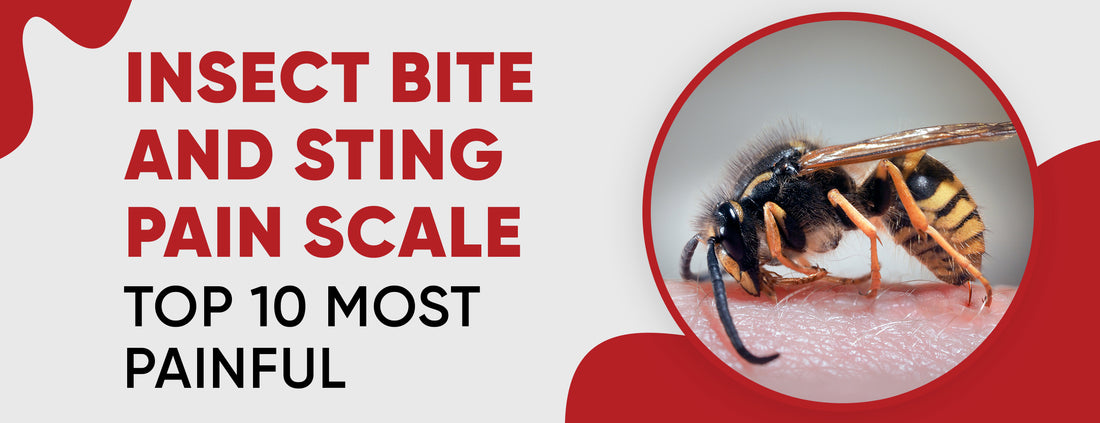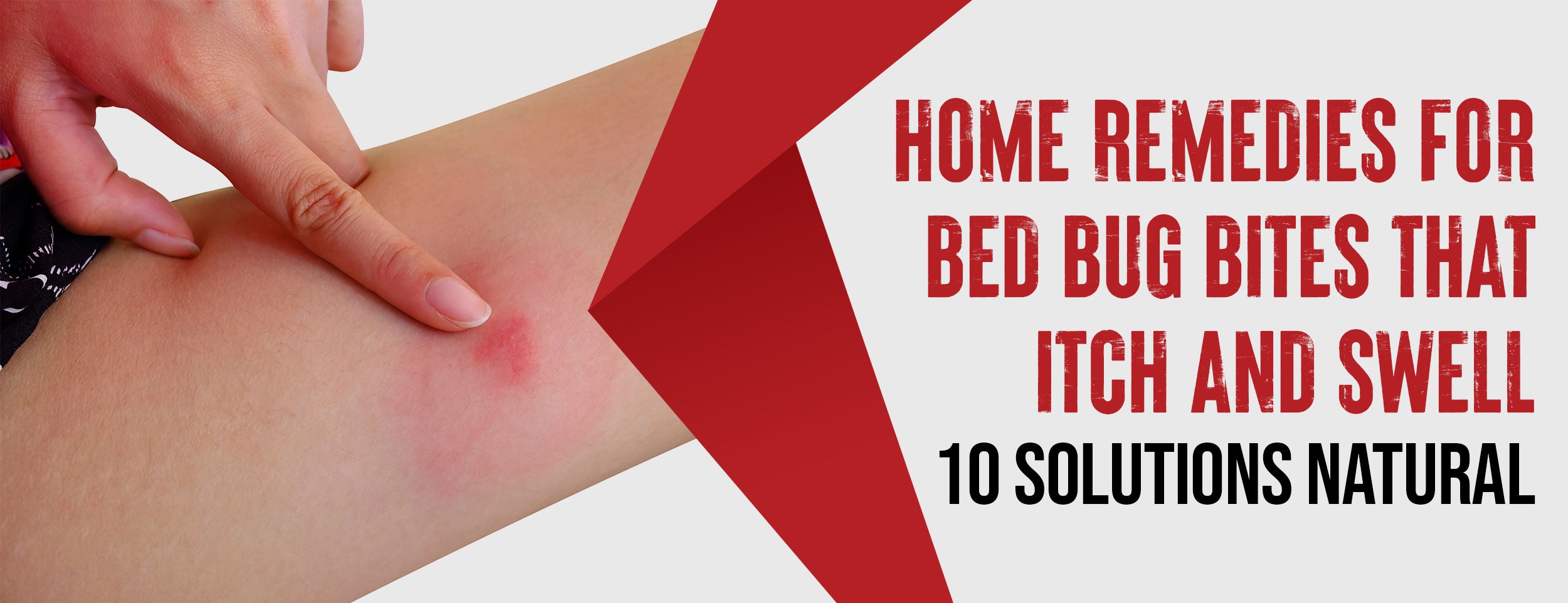Ever wondered how painful an insect sting can be? Justin Schmidt, an entomologist, intentionally let various insects sting him to create the Schmidt Sting Pain Index. This scale rates the pain of insect stings from 1 to 4, with 4 being the most painful.
Schmidt vividly described his experiences, comparing the pain to sensations such as electric shocks or walking over flaming charcoal with a nail in your heel. The index reflects both subjective assessments, the chemical composition and potency of venoms, as well as the size and shape of the stingers.
This blog post delves into insect sting and bite pain, exploring the intricate factors influencing pain perception, its neurological and chemical processes, and the fascinating evolutionary purpose of intense pain.
Insect Bite and Sting Pain Scale: Understanding Pain

Schmidt's index is fascinating for exploring insect venom diversity and helpful for understanding human perception and reaction to pain. Pain is a complex phenomenon influenced by various physical and psychological factors. Factors impacting insect sting pain perception include:
- Neurological Reactions: Insect stings trigger signals from the nervous system to the brain, affecting pain perception. Venom substances may stimulate pain receptors or block pain inhibitors, intensifying the sting. Some venoms have neurotoxic effects leading to numbness, paralysis, or convulsions.
- Chemical Composition of Venoms: Insect venoms differ in chemical makeup and biological activity. Venoms contain proteins, peptides, enzymes, or alkaloids that affect different organs or systems. Examples include inflammation, swelling, itching, blistering of the skin, and nerves. Some venoms prevent blood clotting or destroy red blood cells.
- Individual Pain Thresholds: People experience different pain levels from the same sting due to genetic makeup, past experiences, mood, attention, or coping strategies. Pain thresholds and sensitivity vary, and allergies or immune reactions can influence susceptibility to insect venoms.
10 Most Painful Insect Stings and Bites: Pain Level
Sch's index reveals the top 10 insects inflicting the most excruciating Delving deeper, let's of these remarkable creatures and the intensity of their stings.

Sweat Bee: A Mild Entry (Pain Level 1.0)
Sweat bees, diminutive insects, show an inclination toward human sweat and salt. Typically, they refrain from stinging unless threatened or tangled in clothing or hair. Their sting, while mild, imparts a fleeting burning sensation lasting a few minutes.
One may even describe it as "light, ephemeral, almost fruity," as aptly put by Schmidt. Moreover, sweat bees play a vital role as pollinators for numerous plants and crops, underscoring their importance in the ecosystem.
Fire Ant: The Sweltering Sting (Pain Level 1.2)
Fire ants are considered invasive species, known for their ability to establish large colonies and mounds in warmer regions. These highly aggressive ants fiercely defend their nests and food sources, attacking anything that poses a threat. Interestingly, their notorious sting results from a bite accompanied by venom injection using a modified stinger.
The venom, containing alkaloids, triggers intense pain, itching, and swelling upon contact. Schmidt says it feels like "a flipping matchhead that scorches your skin." It is important to note that fire ant stings can cause severe allergic reactions in some individuals while also threatening crops and local wildlife.
Bald-Faced Hornet and Yellow Jacket: The Prick of Nature (Pain Level 2.0)

Bald-faced hornets and yellow jackets, as social wasps, construct paper nests and feed on insects and nectar. They are defensive creatures, ready to sting if their nest is threatened or if they are disturbed during foraging. Their sting is sharp and piercing, inflicting a burning and throbbing pain that subsides after approximately an hour.
To put it into perspective, Schmidt compares the sensation to "a nail being driven into your cheek." It's important to note that these wasps can stinger multiple times and potentially trigger anaphylaxis in certain individuals.
Red Harvester Ant: Stepping Up the Pain (Pain Level 3.0)
Redvester ants are large creatures that diligently collect and store seeds in their nests. These fascinating insects inhabit arid regions across North America. While they are generally non-aggressive, they possess a potent sting that can inflict deep, enduring pain lasting up to four hours.
Schmidt aptly described this sting as "bold and unrelenting." The venom of red harvester ants contains a neurotoxin that can impact the nervous system, and in some individuals, it can even elicit allergic reactions.
Paper Wasp: Delicate Insect, Stinging Wallop (Pain Level 3.0)
Paper wasps are slender insects constructing nests resembling umbrellas using chewed wood pulp. They can be found worldwide, and their diet consists of insects and nectar. Although generally docile, they will sting when their nest is disturbed or if they feel threatened. The sting is sudden and intense, inducing a burning and throbbing pain lasting up to an hour.
According to Schmidt, it resembles a drop of scorching hot oil landing on your arm. The venom of paper wasps contains substances such as histamine, serotonin, kinins, and peptides, which contribute to inflammation and pain. Additionally, some individuals may experience allergic reactions to their stings.

Bullet Ant: The Excruciating Enigma (Pain Level 4.0+)3>
Bullet ants are colossal insects found in the rainforests of Central and South America. They derive their name from the excruciating sting they deliver, reported to be comparable to that of a bullet wound. This venomous sting inflicts a sharp, blinding, and immobilizing pain, radiating purity, persisting for up to 24 hours.
Renowned for its intensity, the sensation has been likened to traversing flaming coals with a three-inch nail embedded in the heel. The venom of bullet ants contains poneratoxin, a powerful neurotoxin that inhibits nerve transmission and causes muscle spasms, tremors, and profuse perspiration.
Certain indigenous tribes revere these ants, incorporating their stings into sacred initiation ceremonies.
Tarantula Hawk: Blinding Fierce Shock (Pain Level 4.0+)
Tarantula hawks, the large wasps that prey on tarantulas as nourishment for their larvae can be found in warm regions across the Americas, Africa, Asia, and Australia. With a distinctive metallic blue-black body and vibrant orange wings, these creatures possess a sting far from ordinary.
While they are typically non-aggressive, a sting from a tarantula hawk can result in blinding, intense, and shockingly electric pain that induces an immediate loss of control and function in the affected area.
In the words of Schmidt, it is advised to "lie down and scream" in the event of a sting. These fascinating creatures possess venom laden with neurotoxins that target sodium channels, causing unimaginable torment.
Warrior Wasp: Torture in Motion (Pain Level 4.0+)

Warrior wasps, found in the expansive Costa Rican and South American rainforests, are remarkable creatures. These majestic social wasps construct colossal nests called drumming wasps due to their ability to create a resounding drumbeat by rhythmically flapping their wings in times of alarm or threat.
Renowned for their aggressive nature, they fearlessly defend their nests and territories, launching attacks on anything that dares to approach. A sting from these formidable insects is akin to enduring an onslaught of torturous waves, with hours or even days of throbbing pain.
Schmidt eloquently compares the sensation to being immobilized within the fiery currents of an active volcano. The venom of warrior wasps contains mastoparans, potent peptides that induce inflammation, histamine release, cellular damage, and excruciating pain. Truly, nature's intricate tapestry never ceases to astound us with its awe-inspiring marvels.
Executioner Wasp: The Ultimate Agony (Pain Level 4.0+)
Executioner wasps are large social ones living in South and Central American rainforests. They have a black body with yellow stripes and spots on the abdomen and wings. They are extremely aggressive and will attack anything near their nest or territory.
Their sting is the ultimate agony, causing excruciating pain, swelling, bruising, blistering, necrosis, and tissue damage. Schmidt called it “the worst pain known to man.” Executioner wasps have venom that contains cytolytic peptides that destroy cell membranes and cause severe pain and tissue damage.
Asian Giant Hornet: The Merciless Monster (Pain Level 4.0+)
Asian giant hornets, the world's largest hornets, boast a remarkable wingspan of up to 6 cm and wield a formidable stinger measuring up to 6 mm. These hornets, primarily found in Asia but inadvertently introduced to other regions like North America and Europe, are known for their predatory nature, preying on honeybees and various insects.
Highly aggressive in protecting their nests and food sources, they launch ferocious attacks against any potential threats. An encounter with their sting inflicts excruciating pain, swelling, bleeding, necrosis, and even organ failure. Schmidt's chilling portrayal likens the experience to a searing hot nail being driven into one's leg.
The venom of Asian giant hornets contains mandaratoxin, a potent neurotoxin that targets sodium channels, inducing intense pain and nerve damage.
Deciphering The Impact of Insect Sting Pain on Humans

There are a variety of effects caused by insect stings and bites on humans, depending on the type, severity, frequency, and location of the bite or sting. Some of these outcomes include:
- The Psychology of Pain Perception: Humans interpret pain based on emotions, beliefs, expectations, attention, memory, and context. For instance, pain intensity can vary with mood, motivation, and coping skills. Individuals may associate pain with positive or negative outcomes, like reward or punishment. Memory and attention also play a role in pain perception.
- Medical Implications and Allergic Reactions: Insect stings and bites can have various medical implications, like infections, inflammation, tissue or nerve damage, or organ failure. Allergic reactions to insect venoms can range from mild (itching, hives, redness, or swelling) to severe (anaphylaxis). Anaphylaxis is a life-threatening condition with symptoms like difficulty breathing, low blood pressure, rapid heartbeat, nausea, vomiting, or loss of consciousness.
- Coping Mechanisms and Folk Remedies: Humans have developed coping strategies for insect stings and bites, including behavioral, cognitive, emotional, and social techniques. For instance, some may distract themselves or reframe pain as a challenge. They may also express their feelings, seek support, or use folk remedies like ice, vinegar, or aloe vera. Some of these remedies are supported by scientific evidence, while others are based on tradition.

Mitigating The Sting: Prevention and First Aid
Preventing insect stings and bites is key to managing them effectively. If you get stung or bitten, you can take steps to reduce pain and complications. Check out these tips on preventing and treating insect stings and bites:
Minimizing the Risk of Insect Stings and Bites: To minimize the risk of insect stings or bites, consider the following measures:
- Clear areas notorious for insect habitation include gardens, fields, forests, and garbage bins.
- Dress defensively, covering exposed skin with long sleeves, pants, socks, closed-toe shoes, hats, gloves, and veils.
- Apply insect repellents on both skin and clothing, like DEET, picaridin, oil of lemon eucalyptus, or IR3535.
- Refrain from donning bright colors, floral patterns, perfumes, or cosmetics, as they may entice insects.
- Approach and cautiously handle insects and their nests, avoiding sudden movements or attempts to swat at them.
- Before entering your home or vehicle, thoroughly inspect your body and clothing for any lingering insects, gently removing them using a brush or paper.
Swift Responses: First Aid and Treatment Options: If you experience an insect sting or bite, follow these steps:
- Remove the stinger, if present, without squeezing or using tweezers. Scrape it off gently with your fingernail, a credit card, or a blunt knife to avoid injecting more venom.
- Wash the wound thoroughly with soap and water to prevent infection.
- Ease swelling and pain by applying ice or a cold compress to the affected area.
- Take over-the-counter pain relievers like ibuprofen or acetaminophen to alleviate discomfort.
- Reduce itching and inflammation by applying topical creams or ointments, such as hydrocortisone or antihistamines.
- Seek immediate medical attention if you experience severe symptoms such as difficulty breathing, chest pain, swelling, nausea, vomiting, dizziness, or fainting. These could indicate an allergic reaction or life-threatening venom-induced anaphylaxis.
- If you have any medical conditions or allergies that may affect your response to insect stings or bites, it's recommended to consult your doctor. They may advise carrying an epinephrine auto-injector (EpiPen) or prescribe antihistamines or steroids to prevent or treat severe reactions.
Conclusion
We've explored insect bites and stings, their impact on humans and nature, and the Schmidt Sting Pain Index. We've discovered the top 10 most painful stings and bites, their chemical composition, and how they affect us. Neurological reactions, pain thresholds, and psychology influence sting pain perception.
Allergic reactions and medical implications are also important to understand, along with coping strategies. Insect stings contribute to pest control and the coevolutionary arms race.
These experiences give us insight into nature's defense mechanisms and our relationship with insects. They play a vital role in ecosystem balance and harmony. Understanding the science and psychology of insect sting pain prepares us to manage their effects on our well-being. Let's cultivate respect and compassion for these tiny wonders that share our planet.












![6 Reasons Why Itches From Insect Bites Increase at Night [3 OTC Options]](http://drnumb.com/cdn/shop/articles/Why_Do_Insect_Bites_Itch_More_At_Night__6_Factors_4_Natural_Remedies.jpg?v=1709703294)

